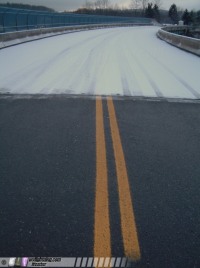Icy Bridges: Taking Drivers by Surprise
 The most insidious type of icy road threat comes from bridges and overpasses. Those signs you always see ARE true. A bridge is exposed to air on all of its surfaces - on top, underneath and on its sides. By contrast, a normal road surface is only exposed to air on one side, its top surface. When temperatures drop, this means bridges will cool and accumulate snow and ice faster than roadways on solid ground (watch the animation above). The most insidious type of icy road threat comes from bridges and overpasses. Those signs you always see ARE true. A bridge is exposed to air on all of its surfaces - on top, underneath and on its sides. By contrast, a normal road surface is only exposed to air on one side, its top surface. When temperatures drop, this means bridges will cool and accumulate snow and ice faster than roadways on solid ground (watch the animation above).
An icy bridge's most dangerous threat is their element of suprise - they catch drivers off guard, who are traveling at full speed because the rest of the roads are either clear or just a little wet. The consequences of driving onto ice at highway speeds can be catastrophic, as the loss of control and impacts happen much faster than in most other conditions. Slides are often unrecoverable and chain-reaction type accidents are common, as additional vehicles will often lose control in the exact same location.
Notice the bridges in the photo gallery - completely covered with a layer of very slick snow and ice, even though the roads before the bridges are totally clear. The transition from clear road to icy takes place in mere inches!
Black ice from freezing rain - an "Invisible Danger"
VIDEO: Icy Bridge Demonstration: Watch video
The photo below is a classic illustration of 'black ice' on a bridge formed from freezing rain. Unlike ice associated with snowfall, ice from freezing rain looks exactly like the wet roads adjacent to it. (Watch a video clip showing the slickness of the invisible 'black ice' this bridge.)
Can you see the ice on this bridge? (Watch video)

< PREVIOUS: Who is at Risk? | NEXT: Danger Zones >
|

